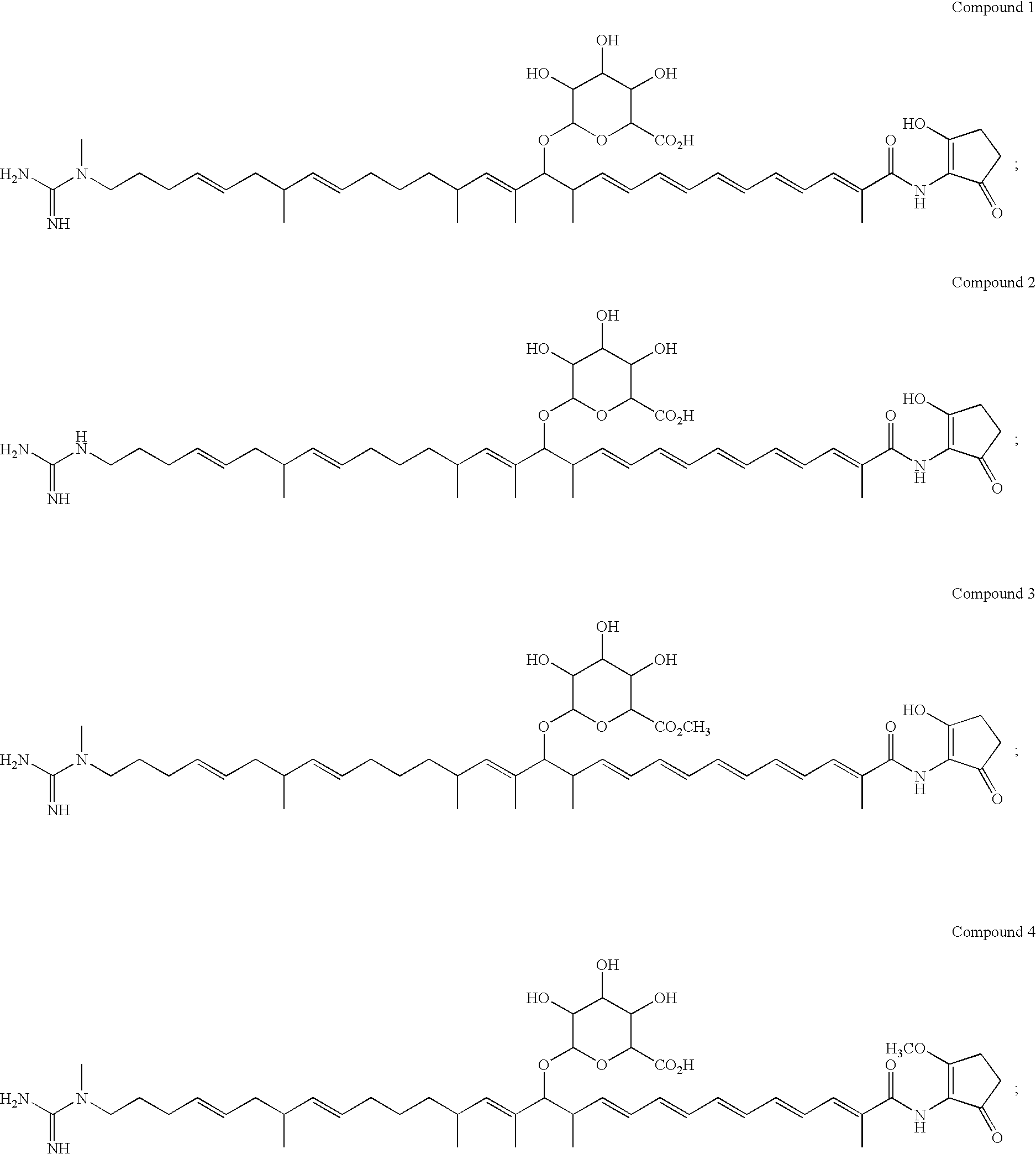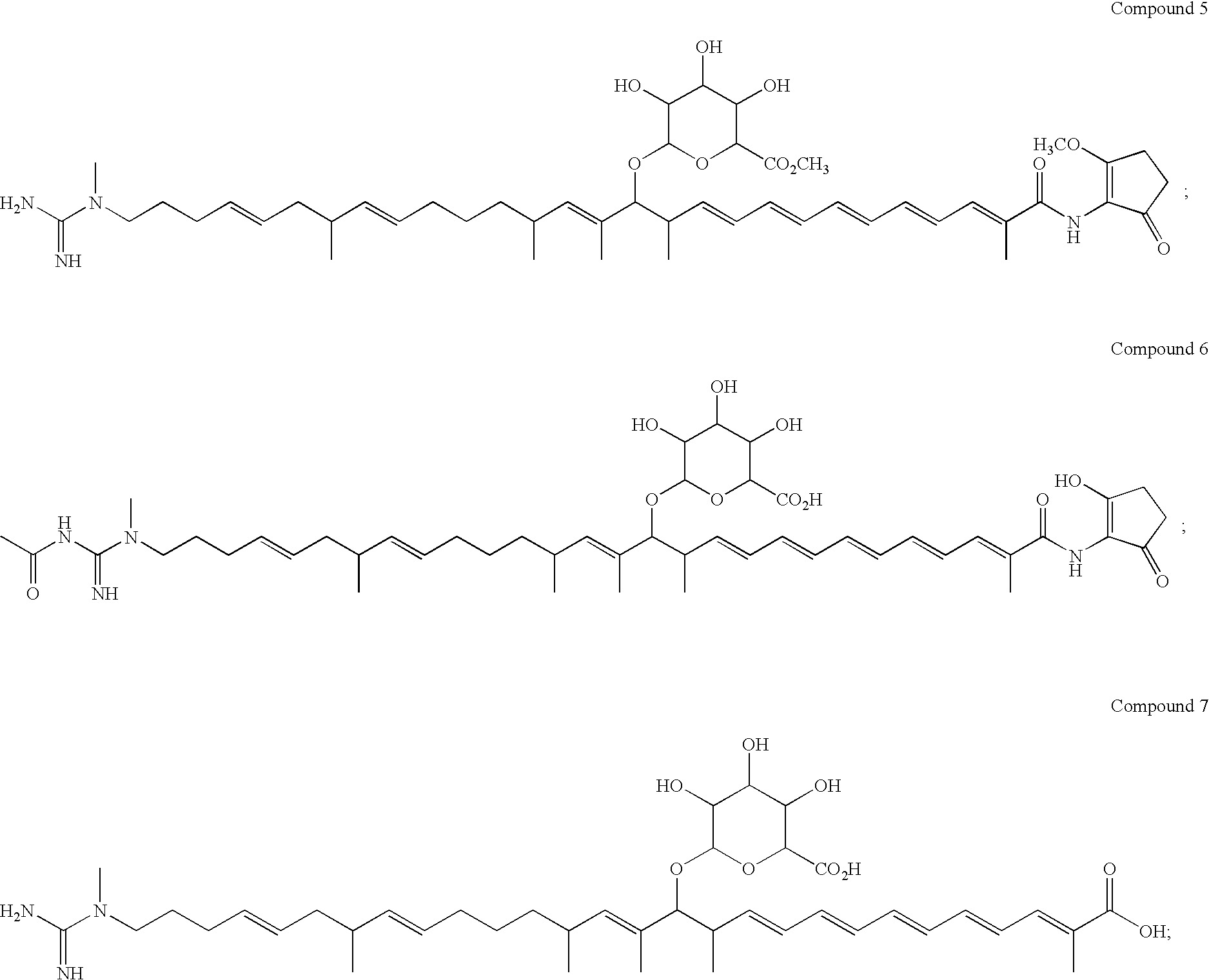Polyene polyketides and methods of production
a polyene polyketide and polymer technology, applied in the field of new biologically active polyene polyketides, can solve the problems of notoriously difficult chemical synthesis of polyketides and inability to obtain novel polyketides by total chemical synthesis
- Summary
- Abstract
- Description
- Claims
- Application Information
AI Technical Summary
Benefits of technology
Problems solved by technology
Method used
Image
Examples
example 1
Genes and Proteins for Producing the Compounds of the Invention
[0254]Amycolatopsis orientalis ATCC™ 43491 was obtained from the American Type Culture Collection (P.O. Box 1549, Manassas, Va. 20108, USA). The biosynthetic locus for the production of the compound of Formula I was identified in the genome of Amycolatopsis orientalis ATCC™ 43491 using the genome scanning method described in U.S. Ser. No. 10 / 232,370, CA 2,352,451 and Zazopoulos et. al., Nature Biotechnol., 21,187-190 (2003).
[0255] The biosynthetic locus spans approximately 100,000 base pairs of DNA and encodes 27 proteins. More than 10 kilobases of DNA sequence were analyzed on each side of the locus and these regions were deemed to contain primary genes or genes unrelated to the synthesis of the compound of Formula I. As illustrated in FIG. 11, the locus is contained within three sequences of contiguous base pairs, namely Contig 1 having the 12,647 contiguous base pairs of SEQ ID NO: 1 and comprising ORFs 1 to 11 (SEQ...
example 2
Production of Compounds 1, 2, 7, 8 and 15 by Fermentation
[0272]Amycolatopsis orientalis ATCC™ 43491 was cultivated under aerobic conditions in an aqueous nutrient medium containing assimilable sources of carbon, assimilable sources of nitrogen, inorganic salts and vitamins. Preferred carbon sources are glucose, glycerol and the like. Preferred nitrogen sources are beef extract, malt extract, yeast extract, and the like. Representative media are provided in Table 1.
[0273] Compounds 1, 2, 7, 8 and 15 were produced by the following procedure: Amycolatopsis orientalis ATCC™ 43491 was maintained and sporulated on agar plates of ISP2 medium (Difco). The innoculum for the production phase was prepared by adding two loopfull of the spores obtained from the surface of the ISP2 agar plate to a 125-ml flask containing 25 ml of ITSB medium (Zahn et al. (2001). Applied and Environmental Microbiology 76, 377-386) composed of 30 g trypticase soy broth (Bacto), 3 g yeast extract, 2 g MgSO4, 5 g g...
example 3
Purification of Compound 1, 2 and 7
[0275] Procedure 1: (for 12×500 mL of Fermentation)
[0276] a) The whole fermentation broth at harvest was centrifuged at 3500 rpm for 20 minutes and the supernatant liquid was decanted and discarded. The residual mycelial pellet was treated with methanol (200 mL / L of original fermentation broth volume), stirred and centrifuged. The methanolic supernatant liquid was removed and the mycelial solid was extracted with acetone, the same manner as the methanol extraction. The combined methanol and acetone extracts are evaporated to dryness to a crude residue.
[0277] b) The crude residue of a) was partitioned between 100 mL(per litre of fermentation) of chloroform (CHCl3) and 100 mL(per litre of fermentation) of methanol (MeOH) in water (3:2) buffered to pH 10 with ammonium hydroxide (NH4OH) and at 10 mM ammonium bicarbonate (NH4HCO3) salt concentration. The two layers were separated and the methanol:water layer evaporated to dryness. The residue from th...
PUM
| Property | Measurement | Unit |
|---|---|---|
| temperature | aaaaa | aaaaa |
| temperature | aaaaa | aaaaa |
| pH | aaaaa | aaaaa |
Abstract
Description
Claims
Application Information
 Login to View More
Login to View More - R&D
- Intellectual Property
- Life Sciences
- Materials
- Tech Scout
- Unparalleled Data Quality
- Higher Quality Content
- 60% Fewer Hallucinations
Browse by: Latest US Patents, China's latest patents, Technical Efficacy Thesaurus, Application Domain, Technology Topic, Popular Technical Reports.
© 2025 PatSnap. All rights reserved.Legal|Privacy policy|Modern Slavery Act Transparency Statement|Sitemap|About US| Contact US: help@patsnap.com



